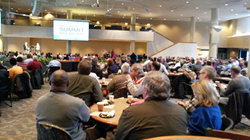In case you missed the latest Willow Creek Association “BizBreakfast” – “Deep Dishing with Marc Malnati”, on Friday, February 21, 2014, at Willow, I put together the following summary of the interview. Marc Malnati is the current owner of the family-owned pizza business Lou Malnati’s. Lou Malnati’s has approximately 36 locations in the Chicagoland area. 
A short disclaimer. I was taking notes and it is entirely possible that some of what I write below from my notes and memory may not be entirely accurate. I accept your grace in advance, and please feel free to correct me!
History
-
In 1978, when he was 22 years old he graduated with a business degree, and the same year his dad died they had to close the Flossmoor store for lack of revenue. They lost about a half-million dollars that took several years to pay off.
-
Marc says, “The mistakes you make early on in your business can kill you.” It is much easier to lose money than make money. One bad business can lose enough money to close three healthy businesses.
-
In 1979 his mom suggested that he set up at “Chicagofest” to sell pizza. The sold more than 80,000 slices of pizza in ten days. That positive experience motivated him to pursue growing the business.
Marc’s Employees and Organizational Culture
-
His employees are willing to treat his business like it was their own. Over 25% of his full-time staff has been with the business for 10 years or more – significantly better than the average for the restaurant business.
-
Their staff, NOT the customer, is the highest priority of the Lou Malnatis business. Of course, the end result of that decision is much better customer experience across the board.
-
People – the staff – their development, care and support – are always the biggest challenge to contend with at Lou Malnatis.
-
One thing he and his staff take pride in is the organizational culture.
Marc’s Secret Sauce for Business Success – Leadership Coaching
-
About 25 years ago, Marc decided to bring in a counselor/executive coach for a two hour off-site meeting with him and his executive staff to help them work through issues. He figured that should be plenty of time. After about 25 minutes of pleasantries, things quickly devolved into yelling, screaming and verbal sparring.
-
Marc decided to schedule a “wrap-up” session for the next month to get the issues completely solved. This time, the pleasantries only lasted a few minutes.
-
Needless to say, those sessions have continued for the last 25 years. The executive leadership team eventually extended these coaching session to other groups of employees to spread the “secret sauce” throughout the organization.
-
He brings his leadership staff to the Willow Leadership Summit every year. The utilize things they learn during the summit. Their latest take away is Bill Hybel’s 6×6 idea he shared at the 2013 Summit.
-
This is almost a direct quote, “If you are going to be around in business a long time, whether you are a Christian-owned business or not, you have to adopt Christian principles.”
-
These principles include integrity, generosity, and “investing in and developing people so they rise to a level beyond which they ever dreamed they could” – **I love that one by the way!! Unleash the Masterpiece!!**
Lawndale Location
-
In 1996, Malnatis had 9 locations. At that time, Wayne Gordon – a Chicago pastor who decided to move his family into one of the poorest and most crime-ridden Chicago neighborhoods – asked Marc Malnati to consider “tithing” his tenth location by opening it in the Lawndale neighborhood. Wayne explained that the area needed a family-owned restaurant where community members could celebrate birthdays, hold business meetings, and just get out and enjoy some good pizza.
-
After a great deal of prayer and discussion, Marc agreed and opened the tenth location in an old, long-vacant and distressed local grocery store. Marc hoped that the location would become a bright spot in that community and be able to provide a health community hangout as well as local jobs for the areas under-resourced residents.
-
For the first 13 years, the area was too dangerous to do deliveries.
-
The Lawndale location recently celebrated their 20 year anniversary, with the last three years being profitable, after more than a million dollar investment.
-
When Marc opened the store, he committed to invest any and all profits back into the community. Since profitability occurred three years ago, Marc has kept that promise.
-
The spirit of the Lawndale location has energized his business over the years
Marc’s Style and Background
-
Marc is a self-proclaimed ready-fire-aim guy and has surrounded himself with people much better than him at planning
-
Marc came to follow Jesus in college in Indiana through Crusade, and the leader of Crusade at his campus named Tom Burnett.
-
When Marc was asked, “How would you describe your leadership?” he respectfully passed on the question.
-
One of his favorite leadership quotes is from General Colin Powell. He said, “I have never had to tell anyone ‘that’s an order’.” Marc loves that and says that you should be able to lead without having to remind people that you are the leader. They should already know and already respect you if you are doing it right.
-
When you go from one location to two, you will
-
Make less money – you will need to get to five stores before your margin improves again
-
Need to transition your leadership skills as an executive from a generalist to a specialist – an expert at developing and growing people.
-
-
Marc would rather tap investors than have to borrow money. If he has to borrow money, he likes to limit it to real estate purchases.
Future Plans
-
Marc plans on opening three new restaurants in 2014. The new stores, couples with the usual turnover, will mean Lou Malnatis needs to hire about 900 new people in 2014.
Jon Stewart and the Daily Show Situation
-
Marc Malnati has been in the news lately regarding an ongoing feud between Chicago-style pizza and New York style pizza
-
Back in November 2013, Jon Stewart went off on deep dish pizza during his show. He said some nasty things that included some inappropriate language
-
“Let me explain something, deep-dish pizza is not only not better than New York pizza. It’s not pizza,” Stewart explained. “It’s a **blanking** casserole!”
-
Stewart went on to liken Chicago-style pizza to “tomato soup in a bread bowl,” “an above-ground marinara swimming pool for rats” and, most damningly, “**blank** with a corpse made of sandpaper.”
-
-
Of course, Marc could not take these accusations lying down. He made a video response and posted it on youtube. The video went viral. You can see it here: Marc Malnati Response to Jon Stewart
-
After the video went viral, Marc was invited to have a discussion with Jon Stewart live during one of his shows. Marc accepted and they buried the hatchet as it were.
-
Marc had never seen the show, but was grateful for the free advertising he got his business given the more than two million viewers of The Daily Show!
My Parting Thoughts
-
Thanks for reading through my summary. I hope it has inspired you.
-
The closing of the meeting, since it was a Christian meeting, discussed a passage from the Bible – Matthew Chapter 5 – about being salt, light, letting your good deeds shine. We were encouraged to carry our salt and light with us and think through the good we can do wherever God has us in our daily lives, including our workplace. Sounds like he is saying we need to express our masterpiece in the “ordinary” living of our lives! Sounds good to me!

